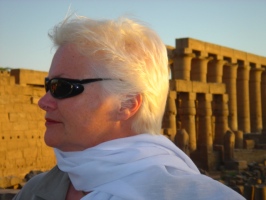His name was Michael, the odd man who took our gaggle of teachers on adventures after the British Infant School education workshop in 1978. Michael explained English history and culture, and he made some extra cash. One such adventure was to see the White Horse of Uffington in the Berkshire hills.

Locals had originally thought the minimalist horse design had been shallowly scratched through the grass into the chalk and was therefore unable to be dated. It may be a minimalist design, but this design is huge: 360 feet long and 130 feet wide. A research team discovered the figure was actually cut up to three feet deep into the hill. That meant it was possible to use the technique “optical stimulated luminescence” to date layers of quartz in the trench. Scientists discovered the design was actually a Bronze Age piece of hill art at least 3,000 years old. During World War II, that quartz outlining the horse was covered over with turf and hedge trimmings so Luftwaffe Stuka dive-bombers couldn’t use it for navigation.
The steep-sided, dry valley below the horse is known as the Manger, and legend says that the great white horse grazes there at night. The Uffington horse is one of several white horses in England and there are direct replicas of the horse in Cockington Green Garden in Australia and Hogansville, Georgia, in the United States. Rosemary Sutcliff’s 1977 children’s book Sun Horse, Moon Horse tells an imagined story of the Bronze Age creator of the figure. The White Horse is also featured in a 1920s setting in the Inspector Ian 1978 television serial The Moon Stallion.
Chalking or “scouring” the horse was already an ancient custom in the Berkshire Downs when Francis Wise wrote about it in 1736: “The ceremony of scouring the Horse, from time immemorial, has been solemnized by a numerous concourse of people from all the villages roundabout.”
Michael maneuvered our van into the parking lot on top of a hill, and we unfolded ourselves out of the cramped van. “This is the White Horse of Uffington,” he wheezed. “Legend has it if you stand in its eye and meditate, you will have a strong son. Anyone game?” I was the only one who was. I was also one of the few who wasn’t married, hadn’t yet met anyone I’d care to marry, and certainly had not been dreaming of any sons or daughters. The eye was about two feet wide, the size of Michael’s van wheel, and I jumped in. I closed my eyes, briefly thought about having a son, incredible as that seemed then, and I scrambled back up the slope.
“Anyone else?” Michael said. The other teachers laughed nervously, but there were no other takers. We returned to roast chicken and gooseberry pie with custard at the workshop’s dining hall. Then we all went our separate ways to the private homes of British teachers who had agreed to house us, bright-eyed with the memory of a giant horse on a hill.
Update: Over four decades after this trip, my first son has just announced he and his wife are expecting a son. I do not know if a white horse was involved, but I do know that time passes. And, if Uffington villagers continue to scour the chalk horse on the hill, my descendants will thrive long after I’m gone.

Post a Comment